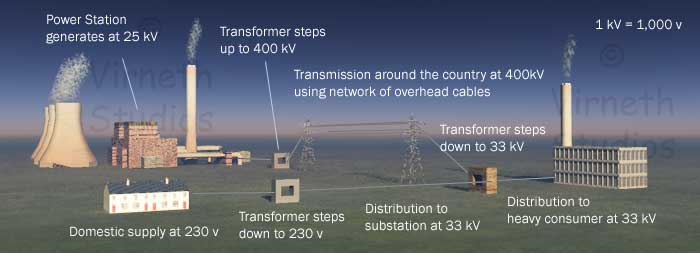Domestic Electricity
Electricity is a common element in the modern home and is vital for many of the appliances that we rely on.
National Grid
Domestic electricity is supplied to the home via a national network of Power Stations and substations. In the UK this is called the National Grid. Power stations create the electricity by driving generators with turbines. The voltage is stepped up from 25 kV (1 kV = 1,000 volts) to around 400kV using a transformer and then distributed around the country via cables, mostly hung from high pylons. Before it reaches the consumer the voltage is stepped down again. In the case of the ordinary domestic house the voltage comes down to 220/240 volts, but in the case of some factories this can still be as high as 33kV.

Electricity is distributed at high voltage across a network of cables suspended from pylons
The reason the power is stepped up is to reduce the power loss during transmission. Consumers need a lot of power, which is determined by the Voltage and Current:
Power (Watts) = Voltage x Current
or
P = V x I
So to transmit a lot of power you need either a high Voltage or a high Current.
The Power loss over a cable is found using the expression P = I2R
Because the power loss is proportional to the square of the current (I2) then boosting the current by a factor of 10 would increase the power loss by 100 times. To reduce the power loss the voltage is boosted instead. This requires transformers and transformers only work with Alternating Current (AC) not Direct Current (DC). The UK National Grid distributes AC power at 50Hz, meaning the current changes direction, or alternates, 50 times each second. In the USA and other parts of the world the frequency is 60Hz.
Power Stations
Power stations generate electricity by heating water to produce vapour that rotates a turbine to drive a generator.
Fossil fuel powered Power Stations burn oil, coal, coke or natural gas to heat water in a boiler. Nuclear powered Power Stations use nuclear fission (splitting atoms) in a reactor to produce the heat for the boiler.
Fossil fuels and Nuclear fuels are non-renewable, they will eventually run out in the next 100 years or so. Alternative sources of power are the so-called renewable sources.
A Circuit Breaker performs a similar function to a fuse but can be re-set. It works by using a spring loaded soft iron bolt to hold a switch in place. An electromagnet is included in the circuit such that if current in the circuit exceeds a certain value the iron bolt is pulled away from the switch allowing it to open and break the circuit.